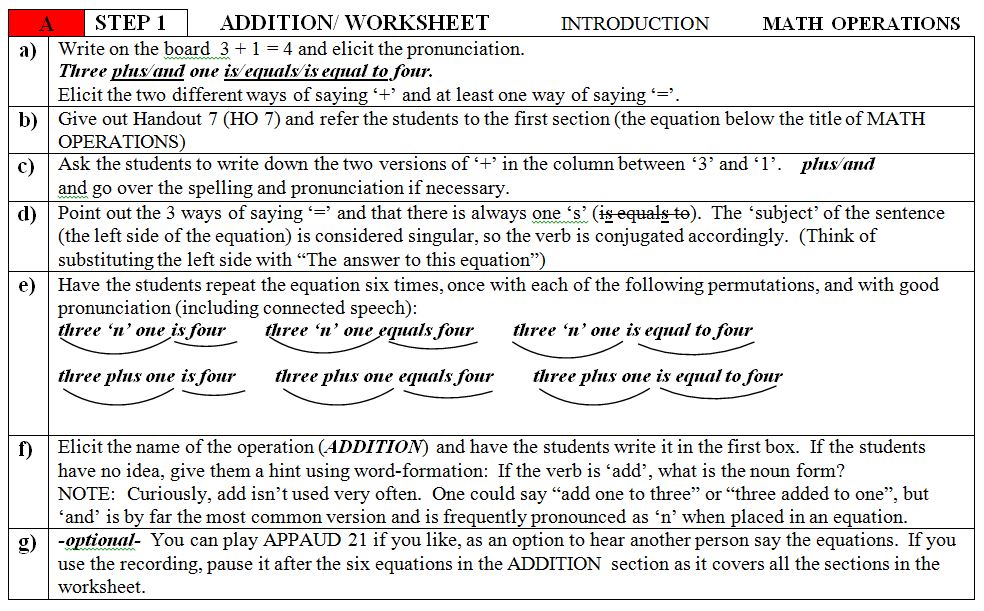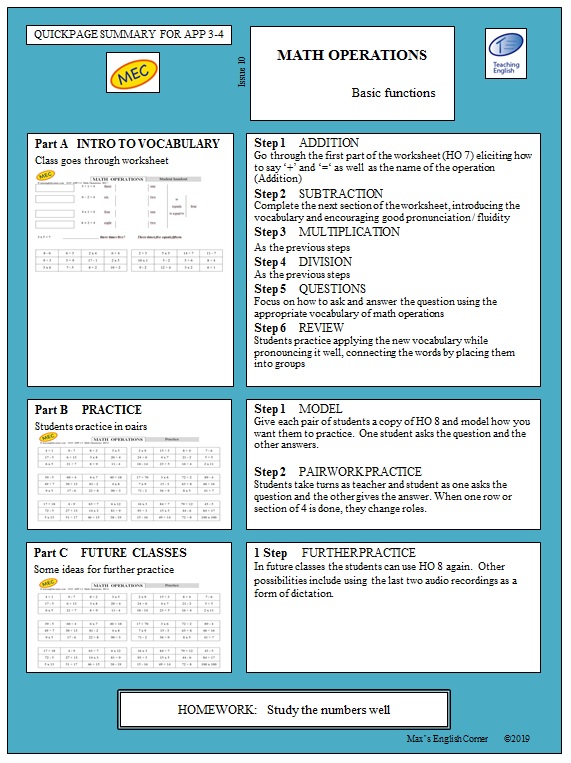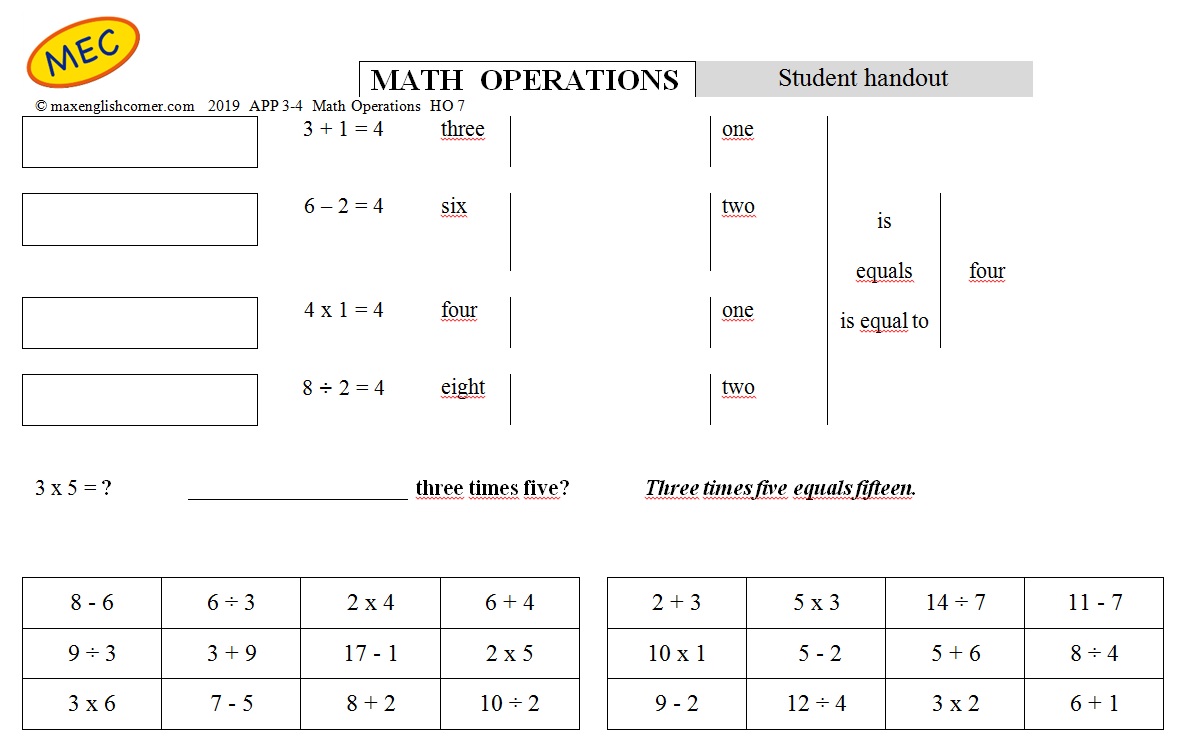Appetizer 3-4 / PRONUNCIATION OF MATH OPERATIONS / Day 1 of 1+
GENERAL AIMS
- To introduce the vocabulary associated with simple math operations
- To practice how to pronounce the vocabulary, including a brief look at reduced forms (‘n’ instead of ‘and’) and connected speech (grouping of words together)
- To increase the students’ confidence in their use of saying the math operations
STEP SUMMARY
|
A |
Intro to vocabulary |
Worksheet on simple math operations |
|
|
B |
Practice |
Pairwork |
|
|
C |
Future classes |
A few ideas |
RECOMMENDED LEVELS
Lower intermediate up
ACTIVITY TIME
about 20 minutes
MATERIALS
- Board, screen or flip chart
- Handouts for class:
HO7 Intro worksheet
HO8 Speaking practice
- Audio APPAUD21 intro HO 7
- Audio APPAUD22 Qs & As on HO 7
- Audio APPAUD23 last 2 rows of HO 7
- Audio APPAUD24 first 3 rows of HO 8
Quickpage
Class Plan
PART A: INTRO TO MATH OPERATIONS
While being able to say the various simple math operations out loud is not a skill normally called upon in daily conversations for most people, it is one of those things that is basic yet gets swept aside in the normal courses. Not much time is needed to cover it and I have found that students often enjoy rounding out their English knowledge by looking at those areas in the margins. And you never know, there could arise an occasion or two where such knowledge would be called into play.

INTRO TO MATH OPERATIONS APPAUD 21
How to say the operations and question on the worksheet HO 7
is is equals equals is equal to is equal to
ADDITION ADDITION
and and n n plus plus
3 ‘n’ 1 is 4 3 ‘n’ 1 equals 4 3 ‘n’ 1 is equal to 4
3 plus 1 is 4 3 plus 1 equals 4 3 plus 1 is equal to 4
SUBTRACTION SUBTRACTION
take away take away minus minus subtract subtract
6 take away 2 is 4 6 minus 2 is 4 6 subtract 2 is 4
MULTIPLICATION MULTIPLICATION
times times multiplied by multiplied by
4 times 1 equals 4 4 times 1 equals 4
4 multiplied by 1 equals 4 4 multiplied by 1 equals 4
DIVISION DIVISION
divided by divided by
8 divided by 2 is 4 8 divided by 2 equals 4
8 divided by 2 is equal to 4
QUESTIONS
How much is 3 times 5?
much is much is chis chis much is much is
How much is How much is
How much is 3 times 5? How much is 3 times 5?
Three times five equals 15.





INTRO TO MATH OPERATIONS APPAUD 22
How to say the operations and question on the worksheet HO 7
How much is …. ? …. is equal to ___
8 take away 6 is 2 6 divided by 3 is equal to 2
2 multiplied by 4 equals 8 6 ‘n’ 4 is 10
2 plus 3 is equal to 5 5 times 3 equals 15
14 divided by 7 is 2 11 subtract 7 is equal to 4
INTRO TO MATH OPERATIONS APPAUD 23
How to say the operations and question on the worksheet HO 7
9 divided by 3 3 ‘n’ 9 17 take away 1 2 times 5
10 multiplied by 1 5 minus 2 5 and 6 8 divided by 4
3 times 6 7 subtract 5 8 plus 2 10 divided by 2
9 take away 2 12 divided by 4 3 multiplied by 2 6 ‘n’ 1
PART B: PRACTICE
| B | STEP 1 | MODEL PRACTICE MATH OPERATIONS | |
| a) | Place students into pairs and give each group one copy of HO 8. | ||
| b) | Choose one student to work with you. You take on the role of ‘teacher’, the one who asks the questions, and your partner takes on the role of ‘student’, the one who answers the questions. | ||
| c) | Ask your student all four operations, making sure that the student responds in ‘complete sentences’ (“Four plus one equals five.” NOT: “5”.) Also make sure that they try to speak fluently, grouping the words and sounds together. | ||
| d) | Change roles, so the student now becomes the teacher, and you are the student. Go through the next four operations. | ||
| e) | Give any last tips. Tell them when they practice in pairs, today they can both follow what is written on their handout but in future classes the student won’t have it and must listen carefully to what the ‘teacher’ is asking. | ||
| B | STEP 2 | PAIR-WORK PRACTICE MATH OPERATIONS | |
| a) | Now the students in pairs do it, taking turns and changing roles each time a block of 4 math operations is completed. Monitor and encourage connected speech and using more than one form (is vs equals / times vs multiplied by etc). Don’t worry about arithmetic mistakes such as 8 x 3 = 16 or 23. Except if you think it’s a conceptual error (ex: 8 x 3 = 11, mistaking times for plus). | ||
| b) | Give feedback at the end of the activity (if their fluency was good, pronunciation, use of ‘s’ in equals/is equal to). | ||
INTRO TO MATH OPERATIONS APPAUD 24
How to say the operations and question on the worksheet HO 7
4 ‘n’ 1 9 take away 7 8 divided by 2 3 times 5
2 multiplied by 9 15 divided by 3 8 plus 4 7 subtract 6
17 minus 5 6 and 13 3 times 8 20 divided by 4
24 divided by 6 4 multiplied by 7 21 take away 2 5 ‘n’ 5
6 times 5 21 divided by 7 8 plus 9 11 minus 4
18 subtract 14 23 and 5 16 divided by 4 2 multiplied by 11
PART C: FUTURE CLASSES
| C | 1 STEP | FUTURE CLASSES FURTHER PRACTICE MATH OPERATIONS | |
| a) | Use HO 8 (handout #8) in future classes as a warmer, filler between changes of focus in your lesson plan, or a closing activity, but always with the idea to strengthen their memory and confidence in using the numbers. Place greater emphasis on fluidity if they already have some familiarity with the functions. | ||
| b) | When practicing in future classes, continue to have students practice in pairs or groups of three as described in Part B above, but only the ‘teacher’ is allowed to look at the sheet. S/He does one or two rows and then they change roles. | ||
| c) | You could do a dictation with APPAUD 23 or APPAUD 24. The students write down the equation as they hear it, but using the appropriate symbols, not the full form in words. | ||
| d) | Another form of dictation would be using APPAUD 23 or APPAUD 24, but the students only write down the answer, not the operation. | ||





